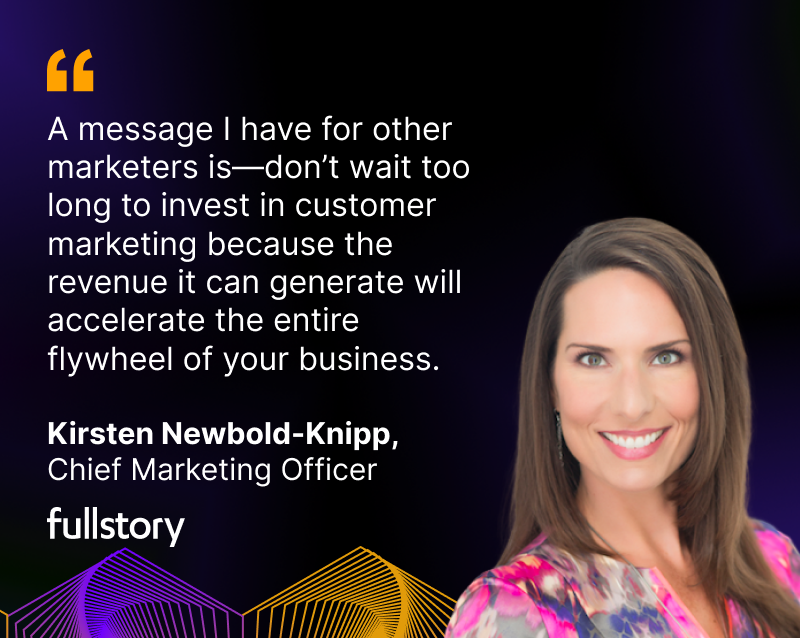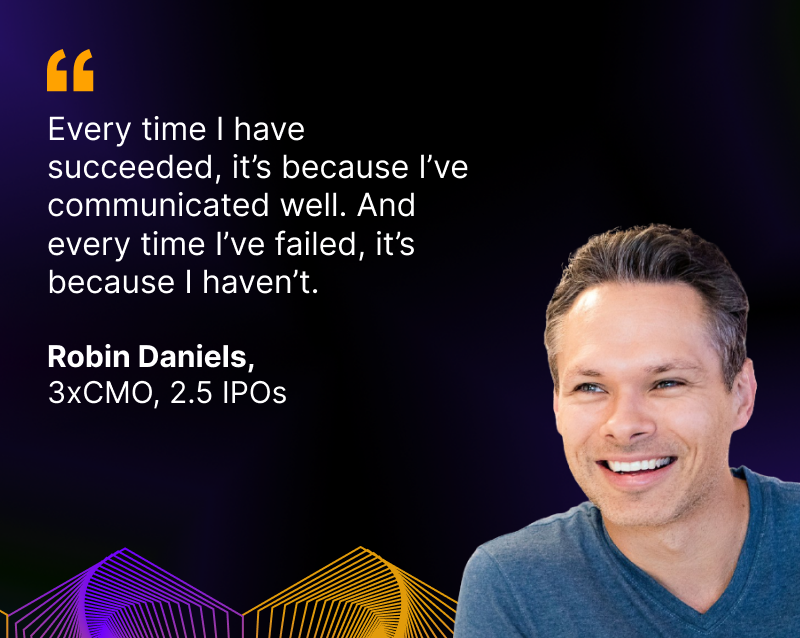Scaling from SMB to Enterprise: Meet Robin Daniels, 3x CMO, and Kirsten Newbold-Knipp from FullStory

Maximize Your Marketing ROI
Join 10,000 other marketers already getting the best tips on running engaging events that boost pipeline and create raving fans.
In this special episode of CMO Diaries, Kishore chats with not one but TWO top marketing leaders—Robin Daniels, 3x CMO, and Kirsten Newbold-Knipp, Chief Marketing Officer at FullStory.
Robin has an impressive resume with experience at brands including Matterport, WeWork, and LinkedIn. He’s currently on sabbatical to enjoy some much-deserved time with family, though we were super lucky to snag him to talk shop in this episode.
Kirsten leads the Go-To-Market motion at FullStory, a digital experience analytics provider. They equip organizations with the information needed to perfect digital experience so that it’s easier for everyone to get things done online.
Robin and Kirsten both come from a product background and shared thought-provoking insight on things like scaling from SMB to Enterprise, when to activate public relations as a startup, setting goals around customer marketing, and much more. Check out the highlights below, and be sure to catch the full episode on-demand!

When it comes to customer marketing, what are your goals and what are you currently doing?
Kirsten:
Customer marketing is a topic that I’m passionate about, and it really extends from this idea of “sell through”. Once you sell the deal, you’re not done.
If you’re in technology, your product likely has more to offer your customers. Whether they’ve bought it and they’re only using a tiny slice of it, so maybe they could be using even more and you retain them. Or, if they bought it and they are using it pretty well, there might be the opportunity to sell more seats or use the product in a different way.
One of the beautiful things about SaaS customer marketing is that there has been a recognition (albeit, sometimes a little too late) that you don’t just get to those customer expansion opportunities by accident, and it shouldn’t just be by throwing bodies at it.
One of the things that I did when I joined FullStory is I observed. There was this unbelievable love for our offering and for how we do business with our customers. And I thought, “this seems like an untapped asset.”
When I worked at HubSpot, we had something similar, and we capitalized on it. We built user groups. We launched a user conference called Inbound. We built a whole customer community, and I thought, “we have the opportunity to do that here, too.” But I didn’t want to do it by accident. I wanted to make sure the function of customer marketing was elevated—both to build advocacy and community and to build pipeline. Just letting a seller figure out how to mine through their accounts to do that is not the most effective use of time.
Now, customer marketing is the fourth pillar in our marketing organization. It is still very small but growing. We have a team leader, someone who works on advocacy, and someone who works on customer engagement and success.
It’s not as simple as the relationship between sales and marketing. Now, it’s sales, marketing, customer experience, product—all of these things play together in a really interesting way to allow us to have a bigger impact on the business. So, rather than hunting and pecking for expansion revenue, we’re very intentional about it.

Customer marketing is a smart but not huge investment that will yield great returns.
What is the hardest part of being a CMO?
Robin:
Communication. The most important skill that you need as a CMO is great communication and the ability to communicate succinctly across all of your stakeholders. Sometimes that’s your boss, sometimes that’s your peers, and sometimes that’s your team. But when you can communicate with clarity, ensuring that everyone is clear on the goals, clear on who is doing what, and clear on the vision—that’s when you will succeed.
The moment you can’t communicate with clarity or there’s confusion around why you’re doing certain things, that’s when you get tension, people talking behind your back, and ultimately, failure.

All of your stakeholders have different mind maps about what they care about. Think about your CFO versus your CRO versus your CEO versus your team. You have to learn how to communicate in a way that gets everyone on the same page.
Kirsten:
Expectation management and motivation management.
So much of success is expectation management. For example, are we all in agreement that “good” looks like “this”?
We can use words that often don’t mean the same thing. As marketers, we say “MQL,” “SAL,” “SQL,” — we use these words that to someone who doesn’t come from a marketing background might have a different meaning. It’s really about understanding your audience and how to manage expectations at a leadership level.
And then at a team level, how do you take those expectations and get people excited that they can achieve them and buy-in that they are part of the mission too.
One of the themes for the marketing kickoff we just hosted was around “co-creation.”
When I first started at FullStory, we were moving so fast to get things done that I came up with a plan and we executed. But once we put out some of the fires, I changed course. I knew that it can’t be just my plan that others execute. Our team has joint goals, so I started asking my team things like: What are your ideas? What would you change? What can we do better?
So, I agree with Robin—ultimately it comes down to communication and knowing these different audiences and how to bring them together.
When is the right time to activate public relations, and how do you use PR to gain momentum?
Robin:
Early and often! When I started at Vera, I came in very early as the CMO. I was about to hire my team and figure out the launch plan. My first hire was a PR Manager because I really wanted us to own the conversation and set the agenda for how our product and market should be talked about.
I’m a huge fan of bringing PR in-house as much as possible. I believe in agencies for an outside perspective on what you could be doing better and for and scaling. But, I believe that the core of the story has to be owned by the team that’s closest to it.
At a small company and in the early days, that might be the Co-Founders or CEO. It should come from the in-house team because you’re still learning and iterating.
What starts happening is that people come to you because they’ve read something interesting about you and your company. The chance of converting someone that way is way higher because they’ve opted-in to hear from you.
As for stories, there are so many different angles you can explore—product stories, people stories, partnership stories, and customer stories.
Of all of these angles, I love telling stories about customers. Ultimately, what moves people is hearing about how your other customers are winning, how they’re becoming heroes at their own company, and how your product is elevating them in their role.
“Tell stories about how they’re becoming a better company by using your product.”
Kirsten:
I agree—my favorite stories to tell are customer stories. They have the opportunity to drive the highest impact and really hit the mark with audiences.
Another type of story I love is data-driven stories.
Sometimes, leaders have these really high media expectations and they think their product is going to get them there. But 90% of the time, unless they have a really, really unique or innovative product, that angle isn’t going to get any attention. But what can work to build thought leadership and drive a really interesting narrative—where even a small company can have a “right” to play—are data-driven stories.
One of the things that I am most proud of is a project during my time at Convey, my company before FullStory. We had access to all of this shipping data, but it was hidden in the product. Sometimes we would use it to give a customer a benchmark, and we eventually realized that we needed to surface all of this great data.
We started small and tested our way into finding the most meaningful data points. It became such a successful engine for us that three important things happened.
One, we convinced the product team to create a public-facing report that we positioned as a benchmark website. It started driving traffic to FullStory because it was the best source for real-time shipping data.
Second, we started pitching everyone on this data, and eventually the Wall Street Journal started using our data as a consistent source, which further increased our visibility in the market.
And third, we started to get direct outreach from executives that we otherwise would have never heard from. They wanted to get this benchmark data for their own company, and the only way to get it was to use Convey.
“How do you tie your data and your knowledge with what’s going on in the world? That’s how you can create something that people care about.”

Transform Your Video Marketing with AI
Stay In Touch
Platform
Resources
© 2025 Copyright Goldcast, Inc. All rights reserved.





 Upcoming Events
Upcoming Events Event Series
Event Series On-Demand Events
On-Demand Events

